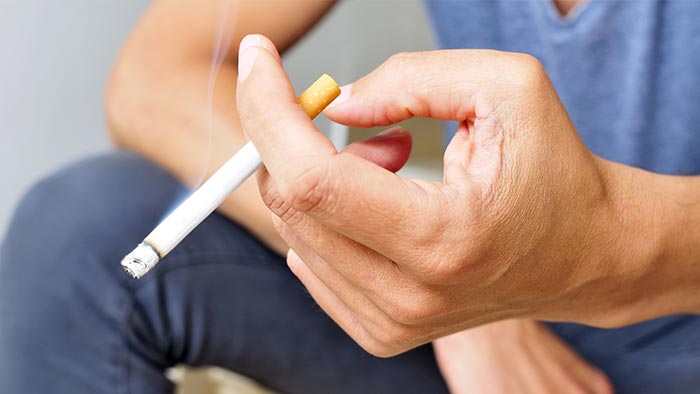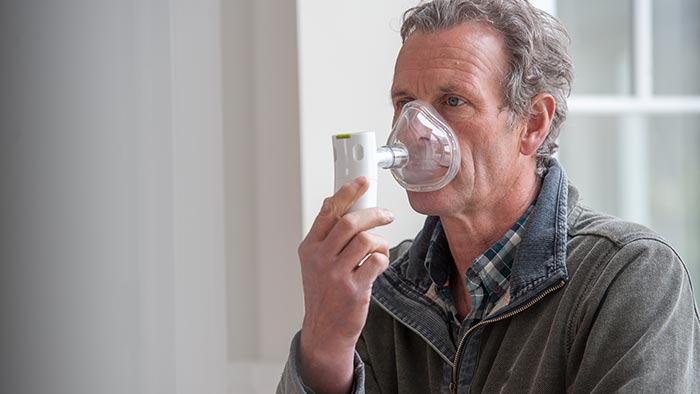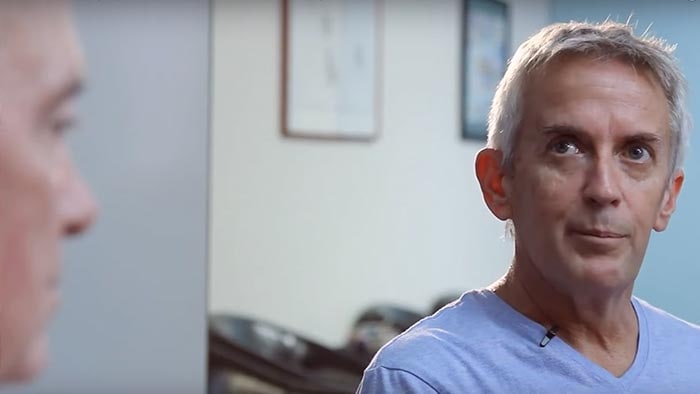Steps you can take to control symptoms
COPD can impact your life on a daily basis, but that doesn’t mean there aren’t opportunities to take control of the things that can trigger your symptoms. Regular treatment and a healthy lifestyle, including regular exercise, a balanced diet and use of breathing techniques, can help you manage COPD by controlling symptoms and slowing the development of further damage to your lungs¹.
How to live with COPD?
COPD athlete Russell Winwood and his physician Dr. Wayne Kelly discuss daily life with COPD.
More information on COPD
-
![Understanding the stages of COPD]()
Understanding the stages of COPD
Click here to learn more -
![Solutions for COPD therapy]()
Solutions for COPD therapy
Click here to learn more
Follow your action plan

Preparing and following an action plan can help you live as normal a life as possible with COPD. A COPD action plan is intended to give you instructions to follow depending on how you feel and the intensity of your symptoms. Action plans are usually structured into green, yellow and red zones that correspond with your symptoms, ranging from normal to more severe. It is also important to stick to the plan even if your breathing feels OK. Seeing your doctor regularly gives you the chance to talk about how you are feeling generally, including flare-ups you may be having and possible changes to medication2.
Avoid common COPD symptom triggers
COPD symptoms can be triggered by your environment, so being aware of what can cause a flare-up may help you better manage your condition day-to-day. Some suggestions to reduce COPD triggers include:
Consider making lifestyle changes
Regular treatment and maintaining a healthy lifestyle can not only help you manage your symptoms, but may aid in slowing the progression of COPD and help you enjoy an active life. Consider the following lifestyle changes and management tips3,4:

Stop or avoid smoking

Excercise regularly

Eating well and maintain a healthy weight

Practice breathing and relaxation techniques

Learn how to cough effectively

Recognize and avoid the factors that trigger flare-ups

Have an action plan for flare-ups

Taking your medication as prescribed

See your doctor regularly, even if you feel well, and especially if you have any concerns
Frequently asked questions
- What is COPD?
-
COPD is a term that covers a number of progressive lung conditions that make breathing difficult, including chronic bronchitis and emphysema¹. One of the main causes is prolonged exposure to cigarette smoke, especially if the smoke is inhaled. However, breathing in second hand smoke, air pollution, chemical fumes and dust from the environment or workplace can also cause COPD².
1. Web MD. What is chronic obstructive pulmonary disease (COPD)?
www.webmd.com/lung/copd/tc/chronic-obstructive-pulmonary-disease-copd-overview
Accessed on 4 August 20152. Web MD. 10 FAQs About Living With COPDWhat is chronic obstructive pulmonary disease (COPD)?
www.webmd.com/lung/copd/10-faqs-about-living-with-copd#2
Accessed on 5 August 2015 - What are the symptoms of COPD?
-
A chronic cough, one that lasts for several weeks without the presence of other illness such as cold or flu, is the first sign of COPD. The cough is usually worse early in the morning, and may be aggravated by exercise or smoke. Other typical symptoms include shortness of breath, wheezing, tightness in the chest and increased mucus (or phlegm) production 1,2.
1. Healthline. Six signs of COPD.
www.healthline.com/health-slideshow/copd-symptoms#9
Accessed on 24 June 2015.2. European Lung Foundation. Lung Factsheet: Living well with COPD.
www.european-lung-foundation.org
Accessed on 19 June 2015. - What causes COPD?
-
One of the main causes of COPD is prolonged exposure to cigarette smoke, especially if the smoke is inhaled. But breathing in secondhand smoke, air pollution, chemical fumes or dust from the workplace also can cause the condition1.
These inhaled particles can cause the mucus glands that line the bronchi to produce more mucus than normal. In addition, the inflammation that they trigger causes the walls of the bronchi to thicken and swell. Environmental factors and genetics may also play a part in the development of COPD 1,2.1. Web MD. 10 FAQs About Living With COPDWhat is chronic obstructive pulmonary disease (COPD)?
www.webmd.com/lung/copd/10-faqs-about-living-with-copd#2
Accessed on 5 August 20152. medicinenet.com. Chronic Bronchitis
www.medicinenet.com/chronic_bronchitis/page3.htmAccessed on 5 August 2015.
- How is COPD treated?
-
Although there is no cure for COPD, there are many effective treatments available to help you manage your symptoms and slow the progression of COPD, so that you can live an active life1.
1. Healthline. COPD and You: Managing Your Symptoms.
www.healthline.com/health/copd/and-you-symptom-management#1Accessed on 10 July 2015.
- How will my illness progress?
-
COPD has four stages, each one with different symptoms of increasing severity. However, by monitoring your symptoms and effectively managing them, it is possible to slow the progression of the disease and to enjoy a more active life1,2.
1. Healthline. COPD and You: Managing Your Symptoms.
www.healthline.com/health/copd/and-you-symptom-management#1Accessed on 10 July 2015.
2. Healthline. COPD: Symptoms and Stages.
www.healthline.com/health/copd/stages#Overview1Access on 6 June 2015.
- What is pulmonary rehab?
-
Combining a program of exercise, education and support, pulmonary rehab can help you live more comfortably with COPD by increasing your capacity for exercise and improving your mobility. You’ll learn about effective breathing techniques, relaxation exercises, the use of medication and oxygen, good nutrition and travel tips, as well as how to avoid flare-ups and stay healthy. Pulmonary rehab also provides an opportunity meet others with COPD to exchange experiences, provide mutual encouragement and increase determination to improve fitness levels and fight the disease1.
1. American Association of Cardiovascular and Pulmonary Rehabilitation (AACVPR). Pulmonary Rehabilitation.
www.copdfoundation.org/Portals/0/Files/pdfs/AACVPR-FactSheet.pdf
Accessed on 6 June 2015. - Is COPD hereditary?
-
Genetics can play a part in the development of COPD, even if you have never smoked or been exposed to pollutants for an extended period of time. In particular, emphysema can be triggered by a deficiency in alpha-1 antitrypsin (AAT), which is a protein that protects the lungs from the harmful effects of white blood cells in the lungs. However, not everyone with COPD who has never smoked has a deficiency on AAT, so it is believed that there must be other genetic triggers for COPD1.
1. COPD Foundation:
www.copdfoundation.org/What-is-COPD/Understanding-COPD/What-is-COPD.aspx#sthash.PjPozNK3.dpufAccessed on 23 June 2015.
- Are there actions I can take to manage my COPD?
-
There are a number of things you can do that will greatly help you to manage your COPD1,2.
- Stop smoking
- Take regular exercise
- Eat well and maintain a healthy weight
- Practice breathing and relaxation techniques
- Learn how to cough effectively
- Recognize and avoid the factors that trigger flare-ups
- Have an action plan for flare-ups
- Take your medications as prescribed
- See your doctor regularly, even if you feel well, and especially if you have any concerns
- Find out if you qualify for pulmonary rehabilitation

Have a product question? We’re here to help

Are you a respiratory health professional?
Did you have a good experience with a Philips product? Help others like you.
References
1 Healthline. COPD: Treatment Options. http://www.healthline.com/health/copd/treatment-options#Overview1 Accessed on 3 August 2015. 2 American Lung Association. Instructions for COPD MANAGEMENT PLAN. http://www.lung.org/lung-disease/copd/living-with-copd/ala-copd-management-plan.pdf Accessed on 15 May 2015. 3 bettersleepandbreathing.com. Minimizing COPD Flareups. Accessed on 3rd August 2015.
4 COPD Foundation. Staying Healthy and Avoiding Exacerbations. http://www.copdfoundation.org/What-is-COPD/Living-with-COPD/Staying-Healthy-and-Avoiding-Exacerbations.aspx Accessed on 3 August 2015.










